Nginx-rtmp直播之業務流程分析--比較詳細
1. 綜述
1.1 直播原理
使用 obs 向 nginx 推送一個直播流,該直播流經 nginx-rtmp 的 ngx_rtmp_live_module 模組轉發給 application live 應用,
然後使用 vlc 連線 live,播放該直播流。
1.2 nginx.conf
# 建立的子程序數 worker_processes 1; error_log stderr debug; daemon off; master_process off; events { worker_connections 1024; } rtmp { server { listen 1935; # rtmp傳輸埠 chunk_size 4096; # 資料傳輸塊大小 application live { # 直播配置 live on; } # obs 將流推到該 push 應用,push 應用又將該流釋出到 live 應用 application push { live on; push rtmp://192.168.1.82:1935/live; # 推流到上面的直播應用 } } }
1.3 obs 推流設定
-
點選 "+" 選擇一個媒體源,確定,然後設定該媒體源,如下圖:

-
點選 "設定" 選擇 "流",設定推流地址,如下圖,確定後即可進行推流:

1.4 使用 vlc 播放直播流
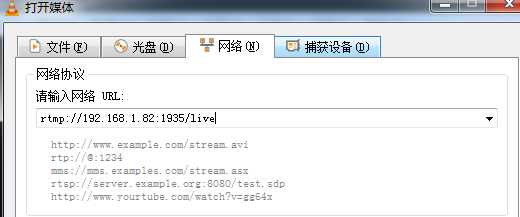
2. 原始碼分析:application push
首先開始分析從 obs 推送 rtmp 流到 nginx 伺服器的整個流程。
2.1 監聽連線
nginx 啟動後,就會一直在 ngx_process_events 函式中的 epoll_eait 處休眠,監聽客戶端的連線:
static ngx_int_t ngx_epoll_process_events(ngx_cycle_t *cycle, ngx_msec_t timer, ngx_uint_t flags) { ... ngx_log_debug1(NGX_LOG_DEBUG_EVENT, cycle->log, 0, "epoll timer: %M", timer); /* nginx 最初執行時,timer 為 -1,即一直等待客戶端連線 */ events = epoll_wait(ep, event_list, (int) nevents, timer); ... for (i = 0; i < events; i++) { c = event_list[i].data.ptr; instance = (uintptr_t) c & 1; c = (ngx_connection_t *) ((uintptr_t) c & (uintptr_t) ~1); /* 獲取被監聽的讀事件 */ rev = c->read; /* 獲取 epoll_wait 返回的事件標誌 */ revents = event_list[i].events; ... /* 若是監聽的事件可讀,首次監聽即表示有新連線到來 */ if ((revents & EPOLLIN) && rev->active) { ... rev->ready = 1; /* 若是開啟了負載均衡,則先將該事件新增到 ngx_posted_accept_events * 延遲佇列中 */ if (flags & NGX_POST_EVENTS) { queue = rev->accept ? &ngx_posted_accept_events : &ngx_posted_events; ngx_post_event(rev, queue); } else { /* 否則,直接呼叫該讀事件的回撥函式,若是新連線則 * 呼叫的是 ngx_event_accept 函式 */ rev->handler(rev); } } ... } return NGX_OK; }
ngx_event_accept 函式中主要也就是接受客戶端的連線,並呼叫該監聽埠對應的回撥函式:
void ngx_event_accept(ngx_event_t *ev) { ... do { ... s = accept(lc->fd, &sa.sockaddr, &socklen); ... /* 呼叫該監聽埠對應的回撥函式,對於 rtmp 模組,則固定為 ngx_rtmp_init_connection */ ls->handler(c); ... } while (ev->available); }
在 ngx_rtmp_init_connection 函式中先經過一系列的初始化後,開始接收與客戶端進行 rtmp 的 handshake 過程。
下面從 hanshake 到 hanshake 成功後接收到第一個 rtmp 包之間僅以圖片說明,就不再分析原始碼了。
2.2 handshake
2.2.1 hs_stage: SERVER_RECV_CHALLENGE(1)
該 hanshake 階段即為等待接收客戶端傳送的 C0 和 C1 階段。
receive: Handshake C0+C1 圖(1)
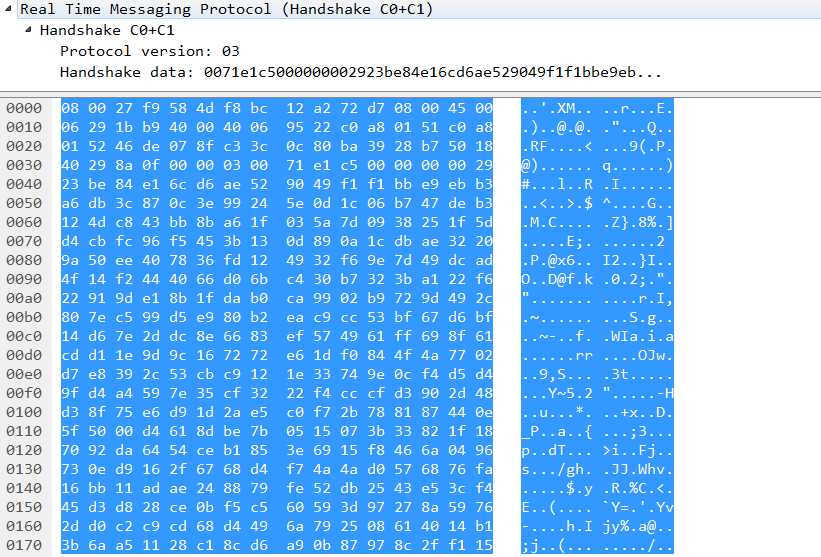
接收到客戶端傳送的 C0 和 C1 後,伺服器進入 NGX_RTMP_HANDSHAKE_SERVER_SEND_CHALLENGE(2)階段,即為
傳送S0 和 S1 階段。
2.2.2 hs_stage: SERVER_SEND_CHALLENGE(2) 和 SERVER_SEND_RESPONSE(3)
該 SERVER_SEND_CHALLENGE 階段即為等待接收客戶端傳送的 S0 和 S1 階段。但是實際上,伺服器在傳送完 S0 和
S1 後,進入到 SERVER_SEND_RESPONSE(3) 階段後又立刻傳送 S2,因此,在抓到的包如下:
send: Handshake S0+S1+S2 圖(2)

2.2.3 hs_stage: SERVER_RECV_RESPONSE(4)
該階段為等待接收客戶端傳送的 C2 階段。
receive:Handshake C2 圖(3)
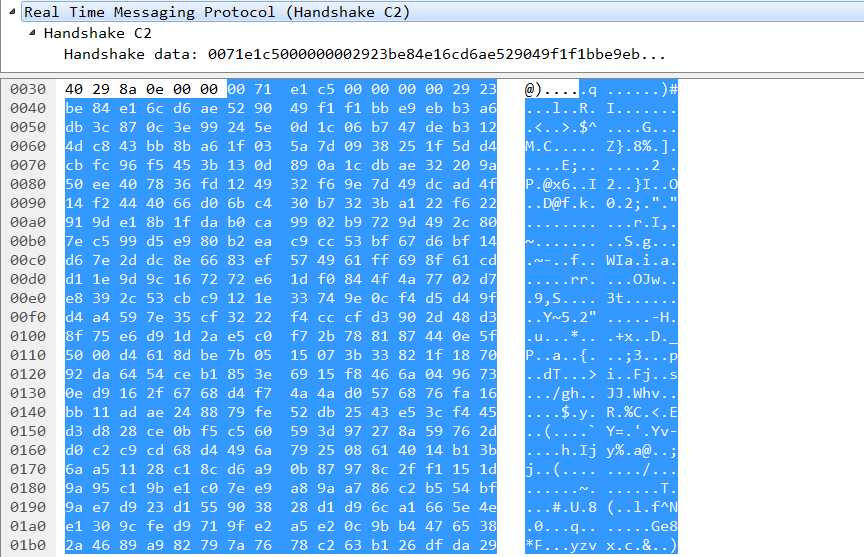
至此,伺服器和客戶端的 rtmp handshake 過程完整,開始正常的資訊互動階段。
如下程式碼,接收到 C2 後,伺服器即進入迴圈處理客戶端的請求階段:ngx_rtmp_cycle
static void
ngx_rtmp_handshake_done(ngx_rtmp_session_t *s)
{
ngx_rtmp_free_handshake_buffers(s);
ngx_log_debug0(NGX_LOG_DEBUG_RTMP, s->connection->log, 0,
"handshake: done");
if (ngx_rtmp_fire_event(s, NGX_RTMP_HANDSHAKE_DONE,
NULL, NULL) != NGX_OK)
{
ngx_rtmp_finalize_session(s);
return;
}
ngx_rtmp_cycle(s);
}ngx_rtmp_cycle 函式中,重新設定了當前 rtmp 連線的讀、寫事件的回撥函式,當監聽到客戶端傳送的資料時,將呼叫
ngx_rtmp_recv 函式進行處理。
void
ngx_rtmp_cycle(ngx_rtmp_session_t *s)
{
ngx_connection_t *c;
c = s->connection;
c->read->handler = ngx_rtmp_recv;
c->write->handler = ngx_rtmp_send;
s->ping_evt.data = c;
s->ping_evt.log = c->log;
s->ping_evt.handler = ngx_rtmp_ping;
ngx_rtmp_reset_ping(s);
ngx_rtmp_recv(c->read);
}在 ngx_rtmp_recv 函式中,會迴圈接收客戶端發來的 rtmp 包資料,接收到完整的一個 rtmp message 後,會根據該訊息
的 rtmp message type,呼叫相應的函式進行處理,如,若為 20,即為 amf0 型別的命令訊息,就會呼叫
ngx_rtmp_amf_message_handler 函式進行處理。
2.3 connect(‘push‘)
hanshake 成功後,接收到客戶端發來的第一個 rtmp 包為連線 nginx.conf 中 rtmp{} 下的 application push{}
應用,如下圖:
receive: connect(‘push‘) 圖(4)
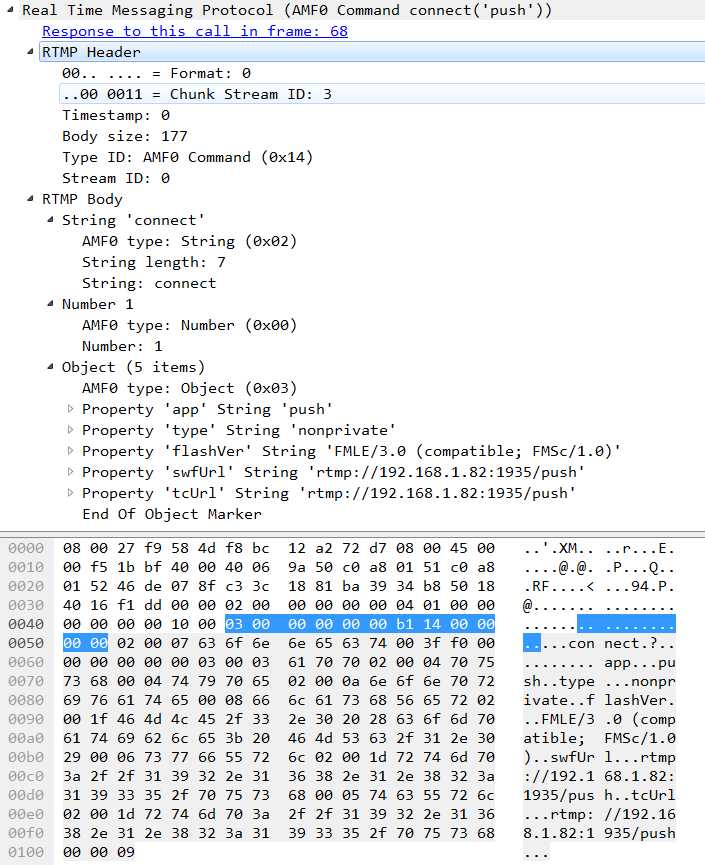
從該圖可知,該訊息型別為 20,即為 AMF0 Command,因此會呼叫 ngx_rtmp_amf_message_handler 對該訊息進行解析,
然後對其中的命令 connect 呼叫預先設定好的 ngx_rtmp_cmd_connect_init 回撥函式。在 ngx_rtmp_cmd_connect_init
函式中,繼續解析該 connect 餘下的訊息後,開始 ngx_rtmp_connect 構件的 connect 函式連結串列,該連結串列中存放著各個
rtmp 模組對該 connect 命令所要做的操作(注:僅有部分 rtmp 模組會對該 connect 命令設定有回撥函式,並且就算
設定了回撥函式,也需要在配置檔案中啟用相應的模組才會真正執行該模組對 connect 的處理)。因此,對於 connect
命令,這裡僅會真正處理 ngx_rtmp_cmd_module 模組設定 ngx_rtmp_cmd_connect 回撥函式。
2.3.1 ngx_rtmp_cmd_connect
static ngx_int_t
ngx_rtmp_cmd_connect(ngx_rtmp_session_t *s, ngx_rtmp_connect_t *v)
{
ngx_log_error(NGX_LOG_INFO, s->connection->log, 0,
"rtmp cmd: connect");
ngx_rtmp_core_srv_conf_t *cscf;
ngx_rtmp_core_app_conf_t **cacfp;
ngx_uint_t n;
ngx_rtmp_header_t h;
u_char *p;
static double trans;
static double capabilities = NGX_RTMP_CAPABILITIES;
static double object_encoding = 0;
/* 以下內容為伺服器將要對客戶端的 connect 命令返回的 amf 型別的響應 */
static ngx_rtmp_amf_elt_t out_obj[] = {
{ NGX_RTMP_AMF_STRING,
ngx_string("fmsVer"),
NGX_RTMP_FMS_VERSION, 0 },
{ NGX_RTMP_AMF_NUMBER,
ngx_string("capabilities"),
&capabilities, 0 },
};
static ngx_rtmp_amf_elt_t out_inf[] = {
{ NGX_RTMP_AMF_STRING,
ngx_string("level"),
"status", 0 },
{ NGX_RTMP_AMF_STRING,
ngx_string("code"),
"NetConnection.Connect.Success", 0 },
{ NGX_RTMP_AMF_STRING,
ngx_string("description"),
"Connection succeeded.", 0 },
{ NGX_RTMP_AMF_NUMBER,
ngx_string("objectEncoding"),
&object_encoding, 0 }
};
static ngx_rtmp_amf_elt_t out_elts[] = {
{ NGX_RTMP_AMF_STRING,
ngx_null_string,
"_result", 0 },
{ NGX_RTMP_AMF_NUMBER,
ngx_null_string,
&trans, 0 },
{ NGX_RTMP_AMF_OBJECT,
ngx_null_string,
out_obj, sizeof(out_obj) },
{ NGX_RTMP_AMF_OBJECT,
ngx_null_string,
out_inf, sizeof(out_inf) },
};
if (s->connected) {
ngx_log_error(NGX_LOG_INFO, s->connection->log, 0,
"connect: duplicate connection");
return NGX_ERROR;
}
cscf = ngx_rtmp_get_module_srv_conf(s, ngx_rtmp_core_module);
trans = v->trans;
/* fill session parameters */
s->connected = 1;
ngx_memzero(&h, sizeof(h));
h.csid = NGX_RTMP_CSID_AMF_INI;
h.type = NGX_RTMP_MSG_AMF_CMD;
#define NGX_RTMP_SET_STRPAR(name) s->name.len = ngx_strlen(v->name); s->name.data = ngx_palloc(s->connection->pool, s->name.len); ngx_memcpy(s->name.data, v->name, s->name.len)
NGX_RTMP_SET_STRPAR(app);
NGX_RTMP_SET_STRPAR(args);
NGX_RTMP_SET_STRPAR(flashver);
NGX_RTMP_SET_STRPAR(swf_url);
NGX_RTMP_SET_STRPAR(tc_url);
NGX_RTMP_SET_STRPAR(page_url);
#undef NGX_RTMP_SET_STRPAR
p = ngx_strlchr(s->app.data, s->app.data + s->app.len, ‘?‘);
if (p) {
s->app.len = (p - s->app.data);
}
s->acodecs = (uint32_t) v->acodecs;
s->vcodecs = (uint32_t) v->vcodecs;
/* 找到客戶端 connect 的應用配置 */
/* find application & set app_conf */
cacfp = cscf->applications.elts;
for(n = 0; n < cscf->applications.nelts; ++n, ++cacfp) {
if ((*cacfp)->name.len == s->app.len &&
ngx_strncmp((*cacfp)->name.data, s->app.data, s->app.len) == 0)
{
/* found app! */
s->app_conf = (*cacfp)->app_conf;
break;
}
}
if (s->app_conf == NULL) {
ngx_log_error(NGX_LOG_INFO, s->connection->log, 0,
"connect: application not found: ‘%V‘", &s->app);
return NGX_ERROR;
}
object_encoding = v->object_encoding;
/* 傳送應答視窗大小:ack_size 給客戶端,該訊息是用來通知對方應答視窗的大小,
* 傳送方在傳送了等於視窗大小的資料之後,等的愛接收對方的應答訊息(在接收
* 到應答訊息之前停止傳送資料)。接收當必須傳送應答訊息,在會話開始時,在
* 會話開始時,會從上一次傳送應答之後接收到了等於視窗大小的資料 */
return ngx_rtmp_send_ack_size(s, cscf->ack_window) != NGX_OK ||
/* 傳送 設定流頻寬訊息。傳送此訊息來說明對方的出口頻寬限制,接收方以此來限制
* 自己的出口頻寬,即限制未被應答的訊息資料大小。接收到此訊息的一方,如果
* 視窗大小與上一次傳送的不一致,應該回復應答視窗大小的訊息 */
ngx_rtmp_send_bandwidth(s, cscf->ack_window,
NGX_RTMP_LIMIT_DYNAMIC) != NGX_OK ||
/* 傳送 設定塊訊息訊息,用來通知對方新的最大的塊大小。 */
ngx_rtmp_send_chunk_size(s, cscf->chunk_size) != NGX_OK ||
ngx_rtmp_send_amf(s, &h, out_elts,
sizeof(out_elts) / sizeof(out_elts[0]))
!= NGX_OK ? NGX_ERROR : NGX_OK;
}send: ack_size 圖(5)
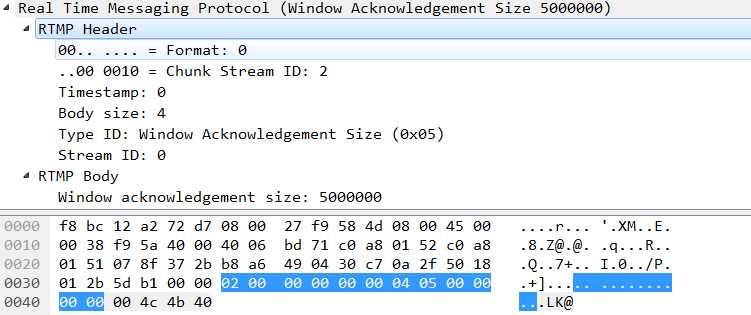
send: peer bandwidth 圖(6)
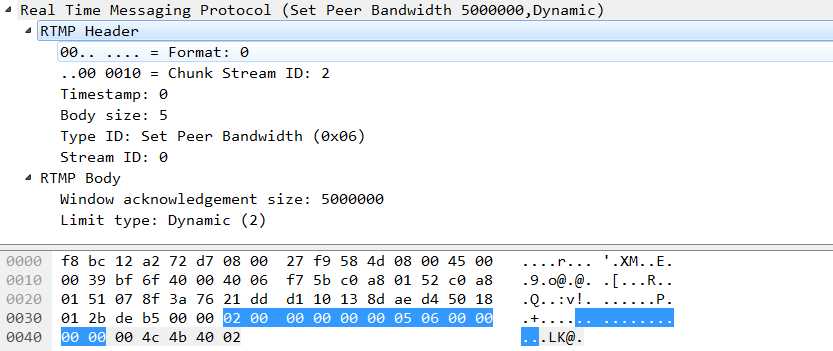
send:chunk_size 圖(7)
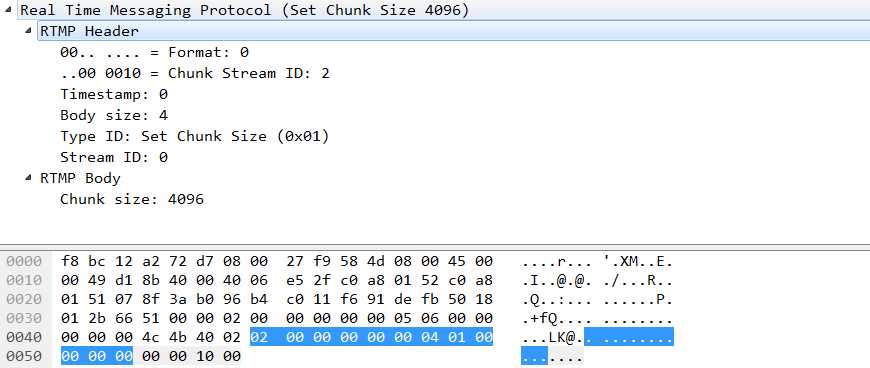
send:_result(‘NetConnection.Connect.Success‘) 圖(8)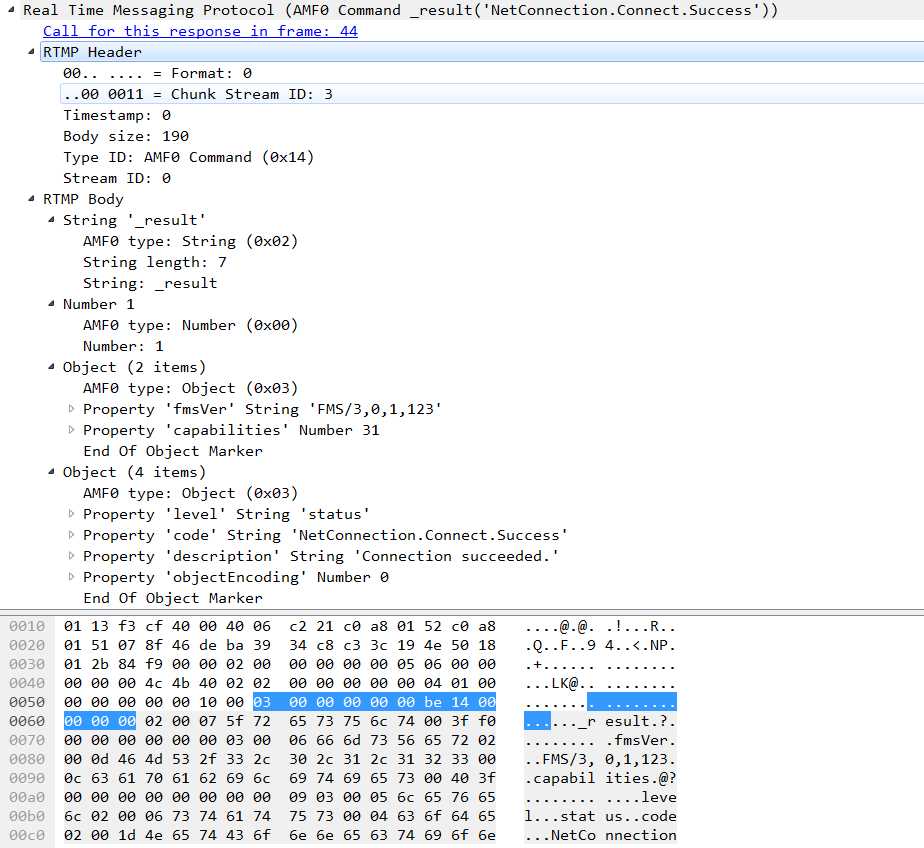
2.4 releaseStream(‘test‘)
伺服器響應客戶端 connect 命令訊息後,客戶端接著傳送 releaseStream 命令訊息給伺服器,但是 nginx-rtmp 中沒有
任何一個 rtmp 模組對該命令設定有回撥函式,因此,不進行處理,接著等待接收下一個訊息。
receive: releaseStream(‘test‘) 圖(9)

2.5 createStream(‘‘)
接著伺服器接收到客戶端發來的 createStream 命令訊息。
receive: createStream(‘‘) 圖(10)
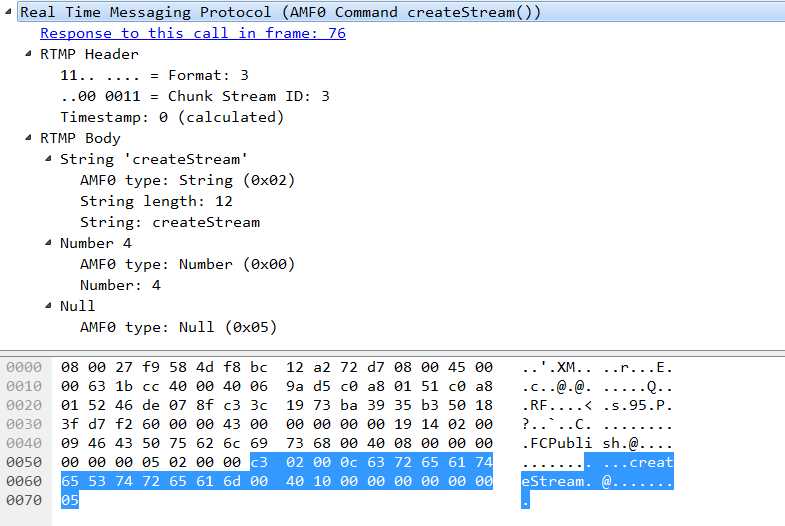
從以前的分析可知,此時,會呼叫 ngx_rtmp_cmd_create_stream_init 函式。
2.5.1 ngx_rtmp_cmd_create_stream_init
static ngx_int_t
ngx_rtmp_cmd_create_stream_init(ngx_rtmp_session_t *s, ngx_rtmp_header_t *h,
ngx_chain_t *in)
{
static ngx_rtmp_create_stream_t v;
static ngx_rtmp_amf_elt_t in_elts[] = {
{ NGX_RTMP_AMF_NUMBER,
ngx_null_string,
&v.trans, sizeof(v.trans) },
};
/* 解析該 createStream 命令訊息,獲取 v.trans 值,從圖(10) 可知,為 4 */
if (ngx_rtmp_receive_amf(s, in, in_elts,
sizeof(in_elts) / sizeof(in_elts[0])))
{
return NGX_ERROR;
}
ngx_log_error(NGX_LOG_INFO, s->connection->log, 0, "createStream");
return ngx_rtmp_create_stream(s, &v);
}接著,從該函式中開始呼叫 ngx_rtmp_create_stream 構建的函式連結串列。這裡呼叫到的是 ngx_rtmp_cmd_create_stream
函式。
2.5.2 ngx_rtmp_cmd_create_stream
static ngx_int_t
ngx_rtmp_cmd_create_stream(ngx_rtmp_session_t *s, ngx_rtmp_create_stream_t *v)
{
ngx_log_error(NGX_LOG_INFO, s->connection->log, 0, "rtmp cmd: create stream");
/* support one message stream per connection */
static double stream;
static double trans;
ngx_rtmp_header_t h;
static ngx_rtmp_amf_elt_t out_elts[] = {
{ NGX_RTMP_AMF_STRING,
ngx_null_string,
"_result", 0 },
{ NGX_RTMP_AMF_NUMBER,
ngx_null_string,
&trans, 0 },
{ NGX_RTMP_AMF_NULL,
ngx_null_string,
NULL, 0 },
{ NGX_RTMP_AMF_NUMBER,
ngx_null_string,
&stream, sizeof(stream) },
};
trans = v->trans;
stream = NGX_RTMP_MSID;
ngx_memzero(&h, sizeof(h));
h.csid = NGX_RTMP_CSID_AMF_INI;
h.type = NGX_RTMP_MSG_AMF_CMD;
return ngx_rtmp_send_amf(s, &h, out_elts,
sizeof(out_elts) / sizeof(out_elts[0])) == NGX_OK ?
NGX_DONE : NGX_ERROR;
}該函式主要是傳送伺服器對 createStream 的響應。
send: _result()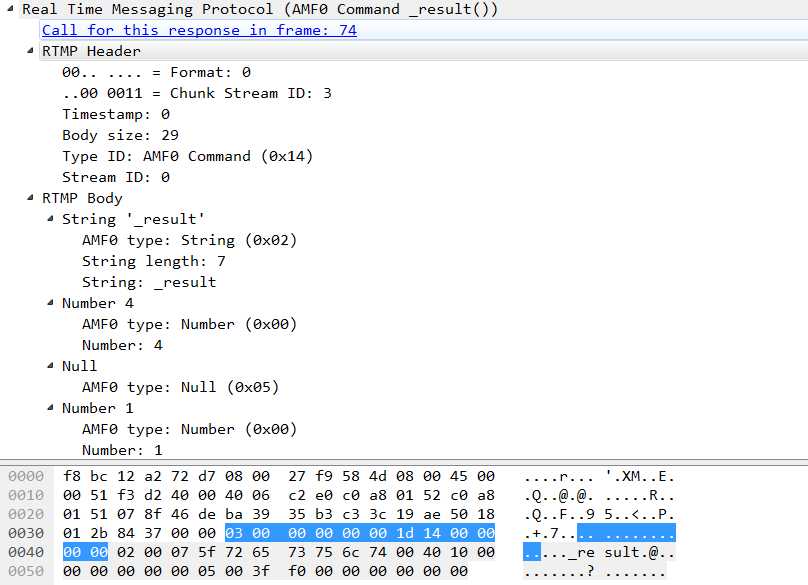
2.6 publish(‘test‘)
接著,客戶端傳送 publish 給伺服器,用來發佈一個有名字的流到伺服器,其他客戶端可以使用此流名來播放流,接收
釋出的音訊,視訊,以及其他資料訊息。
receive:publish(‘test‘) 圖(11)
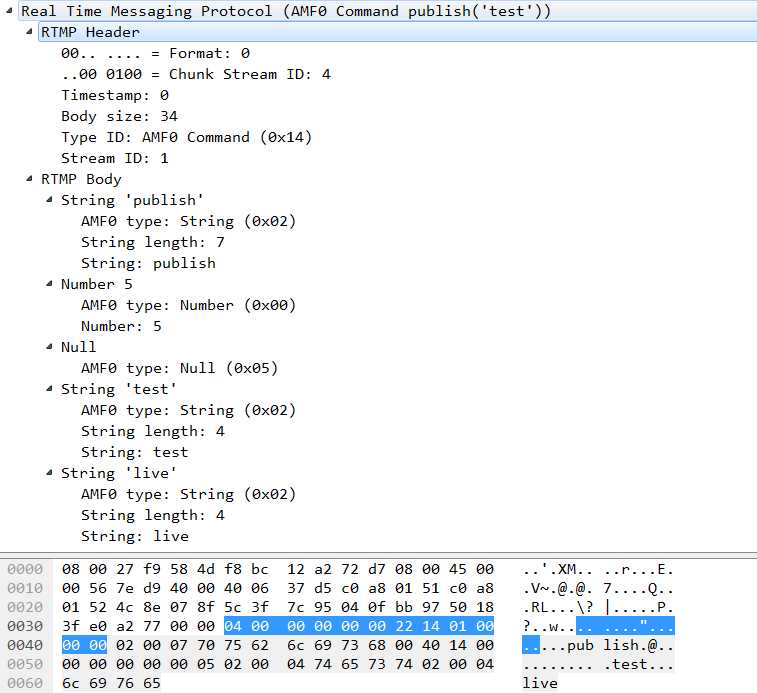
從圖中可知,publish type 為 ‘live‘,即伺服器不會儲存客戶端釋出的流到檔案中。
2.6.1 ngx_rtmp_cmd_publish_init
static ngx_int_t
ngx_rtmp_cmd_publish_init(ngx_rtmp_session_t *s, ngx_rtmp_header_t *h,
ngx_chain_t *in)
{
static ngx_rtmp_publish_t v;
static ngx_rtmp_amf_elt_t in_elts[] = {
/* transaction is always 0 */
{ NGX_RTMP_AMF_NUMBER,
ngx_null_string,
NULL, 0 },
{ NGX_RTMP_AMF_NULL,
ngx_null_string,
NULL, 0 },
{ NGX_RTMP_AMF_STRING,
ngx_null_string,
&v.name, sizeof(v.name) },
{ NGX_RTMP_AMF_OPTIONAL | NGX_RTMP_AMF_STRING,
ngx_null_string,
&v.type, sizeof(v.type) },
};
ngx_memzero(&v, sizeof(v));
/* 從 publish 命令訊息中獲取 in_elts 中指定的值 */
if (ngx_rtmp_receive_amf(s, in, in_elts,
sizeof(in_elts) / sizeof(in_elts[0])))
{
return NGX_ERROR;
}
ngx_rtmp_cmd_fill_args(v.name, v.args);
ngx_log_error(NGX_LOG_INFO, s->connection->log, 0,
"publish: name=‘%s‘ args=‘%s‘ type=%s silent=%d",
v.name, v.args, v.type, v.silent);
return ngx_rtmp_publish(s, &v);
}接著,該函式開始呼叫 ngx_rtmp_publish 構建的函式連結串列。從 nginx-rtmp 的原始碼和 nginx.conf 的配置可知,主要呼叫
ngx_rtmp_relay_publish 和 ngx_rtmp_live_publish 兩個函式。
由 rtmp 模組的排序,首先呼叫 ngx_rtmp_relay_publish。
2.6.2 ngx_rtmp_relay_publish
static ngx_int_t
ngx_rtmp_relay_publish(ngx_rtmp_session_t *s, ngx_rtmp_publish_t *v)
{
ngx_rtmp_relay_app_conf_t *racf;
ngx_rtmp_relay_target_t *target, **t;
ngx_str_t name;
size_t n;
ngx_rtmp_relay_ctx_t *ctx;
if (s->auto_pushed) {
goto next;
}
ctx = ngx_rtmp_get_module_ctx(s, ngx_rtmp_relay_module);
if (ctx && s->relay) {
goto next;
}
racf = ngx_rtmp_get_module_app_conf(s, ngx_rtmp_relay_module);
if (racf == NULL || racf->pushes.nelts == 0) {
goto next;
}
/* v->name 中儲存的是從客戶端傳送的 publish 命令訊息中提取出的要釋出的流名稱 */
name.len = ngx_strlen(v->name);
name.data = v->name;
/* 從 pushes 陣列中取出首元素,遍歷該陣列 */
t = racf->pushes.elts;
for (n = 0; n < racf->pushes.nelts; ++n, ++t) {
target = *t;
/* 配置檔案中是否指定了要推流的名稱,若是,則檢測指定的流名字與當前接收到的publish 流名
* 是否一致 */
if (target->name.len && (name.len != target->name.len ||
ngx_memcmp(name.data, target->name.data, name.len)))
{
continue;
}
if (ngx_rtmp_relay_push(s, &name, target) == NGX_OK) {
continue;
}
ngx_log_error(NGX_LOG_ERR, s->connection->log, 0,
"relay: push failed name=‘%V‘ app=‘%V‘ "
"playpath=‘%V‘ url=‘%V‘",
&name, &target->app, &target->play_path,
&target->url.url);
if (!ctx->push_evt.timer_set) {
ngx_add_timer(&ctx->push_evt, racf->push_reconnect);
}
}
next:
return next_publish(s, v);
}2.6.3 ngx_rtmp_relay_push
ngx_int_t
ngx_rtmp_relay_push(ngx_rtmp_session_t *s, ngx_str_t *name,
ngx_rtmp_relay_target_t *target)
{
ngx_log_error(NGX_LOG_INFO, s->connection->log, 0,
"relay: create push name=‘%V‘ app=‘%V‘ playpath=‘%V‘ url=‘%V‘",
name, &target->app, &target->play_path, &target->url.url);
return ngx_rtmp_relay_create(s, name, target,
ngx_rtmp_relay_create_local_ctx,
ngx_rtmp_relay_create_remote_ctx);
}2.6.4 ngx_rtmp_relay_create
static ngx_int_t
ngx_rtmp_relay_create(ngx_rtmp_session_t *s, ngx_str_t *name,
ngx_rtmp_relay_target_t *target,
ngx_rtmp_relay_create_ctx_pt create_publish_ctx,
ngx_rtmp_relay_create_ctx_pt create_play_ctx)
{
ngx_rtmp_relay_app_conf_t *racf;
ngx_rtmp_relay_ctx_t *publish_ctx, *play_ctx, **cctx;
ngx_uint_t hash;
racf = ngx_rtmp_get_module_app_conf(s, ngx_rtmp_relay_module);
if (racf == NULL) {
return NGX_ERROR;
}
/* 該函式主要是建立一個新的連線,連線推流url中指定的地址,即將該地址作為上游伺服器的地址,
* 向該上游伺服器發起連線 */
play_ctx = create_play_ctx(s, name, target);
if (play_ctx == NULL) {
return NGX_ERROR;
}
hash = ngx_hash_key(name->data, name->len);
cctx = &racf->ctx[hash % racf->nbuckets];
for (; *cctx; cctx = &(*cctx)->next) {
if ((*cctx)->name.len == name->len
&& !ngx_memcmp(name->data, (*cctx)->name.data,
name->len))
{
break;
}
}
if (*cctx) {
play_ctx->publish = (*cctx)->publish;
play_ctx->next = (*cctx)->play;
(*cctx)->play = play_ctx;
return NGX_OK;
}
/* 建立一個本地 ngx_rtmp_relay_ctx_t */
publish_ctx = create_publish_ctx(s, name, target);
if (publish_ctx == NULL) {
ngx_rtmp_finalize_session(play_ctx->session);
return NGX_ERROR;
}
publish_ctx->publish = publish_ctx;
publish_ctx->play = play_ctx;
play_ctx->publish = publish_ctx;
*cctx = publish_ctx;
return NGX_OK;
}2.6.4.1 ngx_rtmp_relay_create_remote_ctx
static ngx_rtmp_relay_ctx_t *
ngx_rtmp_relay_create_remote_ctx(ngx_rtmp_session_t *s, ngx_str_t* name,
ngx_rtmp_relay_target_t *target)
{
ngx_rtmp_conf_ctx_t cctx;
cctx.app_conf = s->app_conf;
cctx.srv_conf = s->srv_conf;
cctx.main_conf = s->main_conf;
return ngx_rtmp_relay_create_connection(&cctx, name, target);
}2.6.4.2 ngx_rtmp_relay_create_connection
static ngx_rtmp_relay_ctx_t *
ngx_rtmp_relay_create_connection(ngx_rtmp_conf_ctx_t *cctx, ngx_str_t* name,
ngx_rtmp_relay_target_t *target)
{
ngx_rtmp_relay_app_conf_t *racf;
ngx_rtmp_relay_ctx_t *rctx;
ngx_rtmp_addr_conf_t *addr_conf;
ngx_rtmp_conf_ctx_t *addr_ctx;
ngx_rtmp_session_t *rs;
ngx_peer_connection_t *pc;
ngx_connection_t *c;
ngx_addr_t *addr;
ngx_pool_t *pool;
ngx_int_t rc;
ngx_str_t v, *uri;
u_char *first, *last, *p;
racf = ngx_rtmp_get_module_app_conf(cctx, ngx_rtmp_relay_module);
ngx_log_debug0(NGX_LOG_DEBUG_RTMP, racf->log, 0,
"relay: create remote context");
pool = NULL;
/* 分配一個記憶體池 */
pool = ngx_create_pool(4096, racf->log);
if (pool == NULL) {
return NULL;
}
/* 從記憶體池中為 ngx_rtmp_relay_ctx_t 結構體分配記憶體 */
rctx = ngx_pcalloc(pool, sizeof(ngx_rtmp_relay_ctx_t));
if (rctx == NULL) {
goto clear;
}
/* 將釋出的流名拷貝到新建的 ngx_rtmp_relay_ctx_t 中的 name 成員 */
if (name && ngx_rtmp_relay_copy_str(pool, &rctx->name, name) != NGX_OK) {
goto clear;
}
/* 將配置檔案中配置的 push 推流地址,即 url 拷貝到新建的 ngx_rtmp_relay_ctx_t
* 結構體的 url 成員中 */
if (ngx_rtmp_relay_copy_str(pool, &rctx->url, &target->url.url) != NGX_OK) {
goto clear;
}
/* target->tag 指向 ngx_rtmp_relay_module 結構體的首地址 */
rctx->tag = target->tag;
/* target->data 指向當前 data 所屬的 ngx_rtmp_relay_ctx_t 結構體的首地址 */
rctx->data = target->data;
#define NGX_RTMP_RELAY_STR_COPY(to, from) if (ngx_rtmp_relay_copy_str(pool, &rctx->to, &target->from) != NGX_OK) { goto clear; }
/* 將以下 target 中的值拷貝到新建的 ngx_rtmp_relay_ctx_t 結構體的相應成員中 */
NGX_RTMP_RELAY_STR_COPY(app, app);
NGX_RTMP_RELAY_STR_COPY(tc_url, tc_url);
NGX_RTMP_RELAY_STR_COPY(page_url, page_url);
NGX_RTMP_RELAY_STR_COPY(swf_url, swf_url);
NGX_RTMP_RELAY_STR_COPY(flash_ver, flash_ver);
NGX_RTMP_RELAY_STR_COPY(play_path, play_path);
rctx->live = target->live;
rctx->start = target->start;
rctx->stop = target->stop;
#undef NGX_RTMP_RELAY_STR_COPY
/* 若 app 的值未知 */
if (rctx->app.len == 0 || rctx->play_path.len == 0) {
/* 這裡是從推流地址中提取出 app 的值,下面分析以 "push rtmp:192.168.1.82:1935/live;"
* 為例,則提出的 live 將賦給 rctx->app */
/* parse uri */
uri = &target->url.uri;
first = uri->data;
last = uri->data + uri->len;
if (first != last && *first == ‘/‘) {
++first;
}
if (first != last) {
/* deduce app */
p = ngx_strlchr(first, last, ‘/‘);
if (p == NULL) {
p = last;
}
if (rctx->app.len == 0 && first != p) {
/* 這裡 v.data 指向 "live" */
v.data = first;
v.len = p - first;
/* 將 "live" 賦給 rctx->app */
if (ngx_rtmp_relay_copy_str(pool, &rctx->app, &v) != NGX_OK) {
goto clear;
}
}
/* deduce play_path */
if (p != last) {
++p;
}
/* 若播放路徑為 NULL 且 p 不等於 last(注,這裡 p 不等於 last 意味著
* "push rtmp:192.168.1.82:1935/live;" 的 "live" 字串後面還有資料,
* 但是,這裡沒有)*/
if (rctx->play_path.len == 0 && p != last) {
v.data = p;
v.len = last - p;
if (ngx_rtmp_relay_copy_str(pool, &rctx->play_path, &v)
!= NGX_OK)
{
goto clear;
}
}
}
}
/* 從記憶體池中為主動連線結構體 ngx_peer_connection_t 分配記憶體 */
pc = ngx_pcalloc(pool, sizeof(ngx_peer_connection_t));
if (pc == NULL) {
goto clear;
}
if (target->url.naddrs == 0) {
ngx_log_error(NGX_LOG_ERR, racf->log, 0,
"relay: no address");
goto clear;
}
/* get address */
/* 獲取 推流地址 url 中指明的伺服器地址(即推流的目標地址)
* 如"push rtmp:192.168.1.82:1935/live;" 中的 "192.168.1.82:1935" */
addr = &target->url.addrs[target->counter % target->url.naddrs];
target->counter++;
/* copy log to keep shared log unchanged */
rctx->log = *racf->log;
pc->log = &rctx->log;
/* 當使用長連線與上游伺服器通訊時,可通過該方法由連線池中獲取一個新連線 */
pc->get = ngx_rtmp_relay_get_peer;
/* 當使用長連線與上游伺服器通訊時,通過該方法將使用完畢的連線釋放給連線池 */
pc->free = ngx_rtmp_relay_free_peer;
/* 遠端伺服器的名稱,這裡其實就是 "192.168.1.82:1935" 該串字串 */
pc->name = &addr->name;
pc->socklen = addr->socklen;
pc->sockaddr = (struct sockaddr *)ngx_palloc(pool, pc->socklen);
if (pc->sockaddr == NULL) {
goto clear;
}
/* 將 addr->sockaddr 中儲存的遠端伺服器的地址資訊拷貝到 pc->sockaddr 中 */
ngx_memcpy(pc->sockaddr, addr->sockaddr, pc->socklen);
/* 開始連線上游伺服器 */
rc = ngx_event_connect_peer(pc);
/* 由 ngx_event_connect_peer 原始碼可知,因為 socket 套接字被設定為非阻塞,
* 因為首次 connect 必定失敗,因此該函式返回 NGX_AGAIN */
if (rc != NGX_OK && rc != NGX_AGAIN ) {
ngx_log_debug0(NGX_LOG_DEBUG_RTMP, racf->log, 0,
"relay: connection failed");
goto clear;
}
c = pc->connection;
c->pool = pool;
/* 推流 URL */
c->addr_text = rctx->url;
addr_conf = ngx_pcalloc(pool, sizeof(ngx_rtmp_addr_conf_t));
if (addr_conf == NULL) {
goto clear;
}
addr_ctx = ngx_pcalloc(pool, sizeof(ngx_rtmp_conf_ctx_t));
if (addr_ctx == NULL) {
goto clear;
}
addr_conf->ctx = addr_ctx;
addr_ctx->main_conf = cctx->main_conf;
addr_ctx->srv_conf = cctx->srv_conf;
ngx_str_set(&addr_conf->addr_text, "ngx-relay");
/* 為該主動連線初始化一個會話 */
rs = ngx_rtmp_init_session(c, addr_conf);
if (rs == NULL) {
/* no need to destroy pool */
return NULL;
}
rs->app_conf = cctx->app_conf;
/* 置該標誌位為 1 */
rs->relay = 1;
rctx->session = rs;
ngx_rtmp_set_ctx(rs, rctx, ngx_rtmp_relay_module);
ngx_str_set(&rs->flashver, "ngx-local-relay");
#if (NGX_STAT_STUB)
(void) ngx_atomic_fetch_add(ngx_stat_active, 1);
#endif
/* 此時作為客戶端,開始向上遊伺服器發說送 hanshake 包,即 C0 + C1 */
ngx_rtmp_client_handshake(rs, 1);
return rctx;
clear:
if (pool) {
ngx_destroy_pool(pool);
}
return NULL;
}2.6.4.3 ngx_event_connect_peer
ngx_int_t
ngx_event_connect_peer(ngx_peer_connection_t *pc)
{
int rc, type;
#if (NGX_HAVE_IP_BIND_ADDRESS_NO_PORT || NGX_LINUX)
in_port_t port;
#endif
ngx_int_t event;
ngx_err_t err;
ngx_uint_t level;
ngx_socket_t s;
ngx_event_t *rev, *wev;
ngx_connection_t *c;
/* 該 get 方法其實沒有做任何處理 */
rc = pc->get(pc, pc->data);
if (rc != NGX_OK) {
return rc;
}
type = (pc->type ? pc->type : SOCK_STREAM);
/* 建立一個 socket 套接字 */
s = ngx_socket(pc->sockaddr->sa_family, type, 0);
ngx_log_debug2(NGX_LOG_DEBUG_EVENT, pc->log, 0, "%s socket %d",
(type == SOCK_STREAM) ? "stream" : "dgram", s);
if (s == (ngx_socket_t) -1) {
ngx_log_error(NGX_LOG_ALERT, pc->log, ngx_socket_errno,
ngx_socket_n " failed");
return NGX_ERROR;
}
/* 從連線池中獲取一個空閒連線 */
c = ngx_get_connection(s, pc->log);
if (c == NULL) {
if (ngx_close_socket(s) == -1) {
ngx_log_error(NGX_LOG_ALERT, pc->log, ngx_socket_errno,
ngx_close_socket_n "failed");
}
return NGX_ERROR;
}
/* 當前 socket 的型別,是 STREAM 還是 DGRAM,這裡為 STREAM */
c->type = type;
/* 若設定了接收緩衝區的大小,從上面知沒有設定 */
if (pc->rcvbuf) {
if (setsockopt(s, SOL_SOCKET, SO_RCVBUF,
(const void *) &pc->rcvbuf, sizeof(int)) == -1)
{
ngx_log_error(NGX_LOG_ALERT, pc->log, ngx_socket_errno,
"setsockopt(SO_RCVBUF) failed");
goto failed;
}
}
/* 將該 socket 套接字設定為非阻塞 */
if (ngx_nonblocking(s) == -1) {
ngx_log_error(NGX_LOG_ALERT, pc->log, ngx_socket_errno,
ngx_nonblocking_n " failed");
goto failed;
}
/* local 儲存的是本地地址資訊,則上面可知,沒有設定 */
if (pc->local) {
#if (NGX_HAVE_TRANSPARENT_PROXY)
if (pc->transparent) {
if (ngx_event_connect_set_transparent(pc, s) != NGX_OK) {
goto failed;
}
}
#endif
#if (NGX_HAVE_IP_BIND_ADDRESS_NO_PORT || NGX_LINUX)
port = ngx_inet_get_port(pc->local->sockaddr);
#endif
#if (NGX_HAVE_IP_BIND_ADDRESS_NO_PORT)
if (pc->sockaddr->sa_family != AF_UNIX && port == 0) {
static int bind_address_no_port = 1;
if (bind_address_no_port) {
if (setsockopt(s, IPPROTO_IP, IP_BIND_ADDRESS_NO_PORT,
(const void *) &bind_address_no_port,
sizeof(int)) == -1)
{
err = ngx_socket_errno;
if (err != NGX_EOPNOTSUPP && err != NGX_ENOPROTOOPT) {
ngx_log_error(NGX_LOG_ALERT, pc->log, err,
"setsockopt(IP_BIND_ADDRESS_NO_PORT) "
"failed, ignored");
} else {
bind_address_no_port = 0;
}
}
}
}
#endif
#if (NGX_LINUX)
if (pc->type == SOCK_DGRAM && port != 0) {
int reuse_addr = 1;
if (setsockopt(s, SOL_SOCKET, SO_REUSEADDR,
(const void *) &reuse_addr, sizeof(int))
== -1)
{
ngx_log_error(NGX_LOG_ALERT, pc->log, ngx_socket_errno,
"setsockopt(SO_REUSEADDR) failed");
goto failed;
}
}
#endif
if (bind(s, pc->local->sockaddr, pc->local->socklen) == -1) {
ngx_log_error(NGX_LOG_CRIT, pc->log, ngx_socket_errno,
"bind(%V) failed", &pc->local->name);
goto failed;
}
}
if (type == SOCK_STREAM) {
/* 設定當前連線的 IO 回撥函式 */
c->recv = ngx_recv;
c->send = ngx_send;
c->recv_chain = ngx_recv_chain;
c->send_chain = ngx_send_chain;
/* 使用 sendfile */
c->sendfile = 1;
if (pc->sockaddr->sa_family == AF_UNIX) {
c->tcp_nopush = NGX_TCP_NOPUSH_DISABLED;
c->tcp_nodelay = NGX_TCP_NODELAY_DISABLED;
#if (NGX_SOLARIS)
/* Solaris‘s sendfilev() supports AF_NCA, AF_INET, and AF_INET6 */
c->sendfile = 0;
#endif
}
} else { /* type == SOCK_DGRAM */
c->recv = ngx_udp_recv;
c->send = ngx_send;
c->send_chain = ngx_udp_send_chain;
}
c->log_error = pc->log_error;
/* 設定當前主動連線讀寫事件的回撥函式 */
rev = c->read;
wev = c->write;
rev->log = pc->log;
wev->log = pc->log;
pc->connection = c;
c->number = ngx_atomic_fetch_add(ngx_connection_counter, 1);
/* 將該主動連線的讀寫事件新增到 epoll 等事件監控機制中 */
if (ngx_add_conn) {
if (ngx_add_conn(c) == NGX_ERROR) {
goto failed;
}
}
ngx_log_debug3(NGX_LOG_DEBUG_EVENT, pc->log, 0,
"connect to %V, fd:%d #%uA", pc->name, s, c->number);
/* 連線該上游伺服器,因為該 socket 套接字被設定為非阻塞,因此首次connect返回 -1,即失敗 */
rc = connect(s, pc->sockaddr, pc->socklen);
if (rc == -1) {
err = ngx_socket_errno;
if (err != NGX_EINPROGRESS
#if (NGX_WIN32)
/* Winsock returns WSAEWOULDBLOCK (NGX_EAGAIN) */
&& err != NGX_EAGAIN
#endif
)
{
if (err == NGX_ECONNREFUSED
#if (NGX_LINUX)
/*
* Linux returns EAGAIN instead of ECONNREFUSED
* for unix sockets if listen queue is full
*/
|| err == NGX_EAGAIN
#endif
|| err == NGX_ECONNRESET
|| err == NGX_ENETDOWN
|| err == NGX_ENETUNREACH
|| err == NGX_EHOSTDOWN
|| err == NGX_EHOSTUNREACH)
{
level = NGX_LOG_ERR;
} else {
level = NGX_LOG_CRIT;
}
ngx_log_error(level, c->log, err, "connect() to %V failed",
pc->name);
ngx_close_connection(c);
pc->connection = NULL;
return NGX_DECLINED;
}
}
/* 因此,從這裡返回 NGX_AGAIN */
if (ngx_add_conn) {
if (rc == -1) {
/* NGX_EINPROGRESS */
return NGX_AGAIN;
}
ngx_log_debug0(NGX_LOG_DEBUG_EVENT, pc->log, 0, "connected");
wev->ready = 1;
return NGX_OK;
}
if (ngx_event_flags & NGX_USE_IOCP_EVENT) {
ngx_log_debug1(NGX_LOG_DEBUG_EVENT, pc->log, ngx_socket_errno,
"connect(): %d", rc);
if (ngx_blocking(s) == -1) {
ngx_log_error(NGX_LOG_ALERT, pc->log, ngx_socket_errno,
ngx_blocking_n " failed");
goto failed;
}
/*
* FreeBSD‘s aio allows to post an operation on non-connected socket.
* NT does not support it.
*
* TODO: check in Win32, etc. As workaround we can use NGX_ONESHOT_EVENT
*/
rev->ready = 1;
wev->ready = 1;
return NGX_OK;
}
if (ngx_event_flags & NGX_USE_CLEAR_EVENT) {
/* kqueue */
event = NGX_CLEAR_EVENT;
} else {
/* select, poll, /dev/poll */
event = NGX_LEVEL_EVENT;
}
if (ngx_add_event(rev, NGX_READ_EVENT, event) != NGX_OK) {
goto failed;
}
if (rc == -1) {
/* NGX_EINPROGRESS */
if (ngx_add_event(wev, NGX_WRITE_EVENT, event) != NGX_OK) {
goto failed;
}
return NGX_AGAIN;
}
ngx_log_debug0(NGX_LOG_DEBUG_EVENT, pc->log, 0, "connected");
wev->ready = 1;
return NGX_OK;
failed:
ngx_close_connection(c);
pc->connection = NULL;
return NGX_ERROR;
}2.6.4.4 ngx_rtmp_client_handshake
void
ngx_rtmp_client_handshake(ngx_rtmp_session_t *s, unsigned async)
{
ngx_connection_t *c;
c = s->connection;
/* 設定當前連線讀寫事件的回撥函式 */
c->read->handler = ngx_rtmp_handshake_recv;
c->write->handler = ngx_rtmp_handshake_send;
ngx_log_debug0(NGX_LOG_DEBUG_RTMP, s->connection->log, 0,
"handshake: start client handshake");
/* 為該將要進行的 hanshake 過程分配資料快取,用於儲存接收/響應的 hanshake 包 */
s->hs_buf = ngx_rtmp_alloc_handshake_buffer(s);
/* 設定當前 hanshake 階段,即為 client send: C0 + C1 */
s->hs_stage = NGX_RTMP_HANDSHAKE_CLIENT_SEND_CHALLENGE;
/* 構建 C0 + C1 的 資料包 */
if (ngx_rtmp_handshake_create_challenge(s,
ngx_rtmp_client_version,
&ngx_rtmp_client_partial_key) != NGX_OK)
{
ngx_rtmp_finalize_session(s);
return;
}
/* 有前面的呼叫傳入的引數可知,該值為 1,即為非同步,因此這裡暫時不向上游伺服器傳送 handshake,
* 而是將其寫事件新增到定時器和 epoll 中,等待下次迴圈監控到該寫事件可寫時才傳送 C0 + C1 */
if (async) {
/* 將該寫事件新增到定時器中,超時時間為 s->timeout */
ngx_add_timer(c->write, s->timeout);
/* 將該寫事件新增到 epoll 等事件監控機制中 */
if (ngx_handle_write_event(c->write, 0) != NGX_OK) {
ngx_rtmp_finalize_session(s);
}
return;
}
ngx_rtmp_handshake_send(c->write);
}2.6.4.5 ngx_rtmp_relay_create_local_ctx
static ngx_rtmp_relay_ctx_t *
ngx_rtmp_relay_create_local_ctx(ngx_rtmp_session_t *s, ngx_str_t *name,
ngx_rtmp_relay_target_t *target)
{
ngx_rtmp_relay_ctx_t *ctx;
ngx_log_debug0(NGX_LOG_DEBUG_RTMP, s->connection->log, 0,
"relay: create local context");
ctx = ngx_rtmp_get_module_ctx(s, ngx_rtmp_relay_module);
if (ctx == NULL) {
ctx = ngx_pcalloc(s->connection->pool, sizeof(ngx_rtmp_relay_ctx_t));
if (ctx == NULL) {
return NULL;
}
ngx_rtmp_set_ctx(s, ctx, ngx_rtmp_relay_module);
}
ctx->session = s;
ctx->push_evt.data = s;
ctx->push_evt.log = s->connection->log;
/* 設定該 push_evt 事件的回撥函式 */
ctx->push_evt.handler = ngx_rtmp_relay_push_reconnect;
if (ctx->publish) {
return NULL;
}
if (ngx_rtmp_relay_copy_str(s->connection->pool, &ctx->name, name)
!= NGX_OK)
{
return NULL;
}
return ctx;
}從 ngx_rtmp_relay_create_local_ctx 函式返回後,就一直返回到 ngx_rtmp_relay_publish 函式中,接著執行 next_publish 的下
一個函式。這裡為 ngx_rtmp_live_publish。
2.6.5 ngx_rtmp_live_publish
static ngx_int_t
ngx_rtmp_live_publish(ngx_rtmp_session_t *s, ngx_rtmp_publish_t *v)
{
ngx_rtmp_live_app_conf_t *lacf;
ngx_rtmp_live_ctx_t *ctx;
lacf = ngx_rtmp_get_module_app_conf(s, ngx_rtmp_live_module);
if (lacf == NULL || !lacf->live) {
goto next;
}
ngx_log_debug2(NGX_LOG_DEBUG_RTMP, s->connection->log, 0,
"live: publish: name=‘%s‘ type=‘%s‘",
v->name, v->type);
/* join stream as publisher */
/* 構建一個 ngx_rtmp_live_ctx_t 結構體作為釋出者 */
ngx_rtmp_live_join(s, v->name, 1);
/* 這裡獲取到的就是上面構建的 ngx_rtmp_live_ctx_t 結構體 */
ctx = ngx_rtmp_get_module_ctx(s, ngx_rtmp_live_module);
if (ctx == NULL || !ctx->publishing) {
goto next;
}
ctx->silent = v->silent;
if (!ctx->silent) {
/* 對之前客戶端傳送的 publish 返回一個響應 */
ngx_rtmp_send_status(s, "NetStream.Publish.Start",
"status", "Start publishing");
}
next:
return next_publish(s, v);
}send: onStatus(‘NetStream.Publish.Start‘) 圖(12)
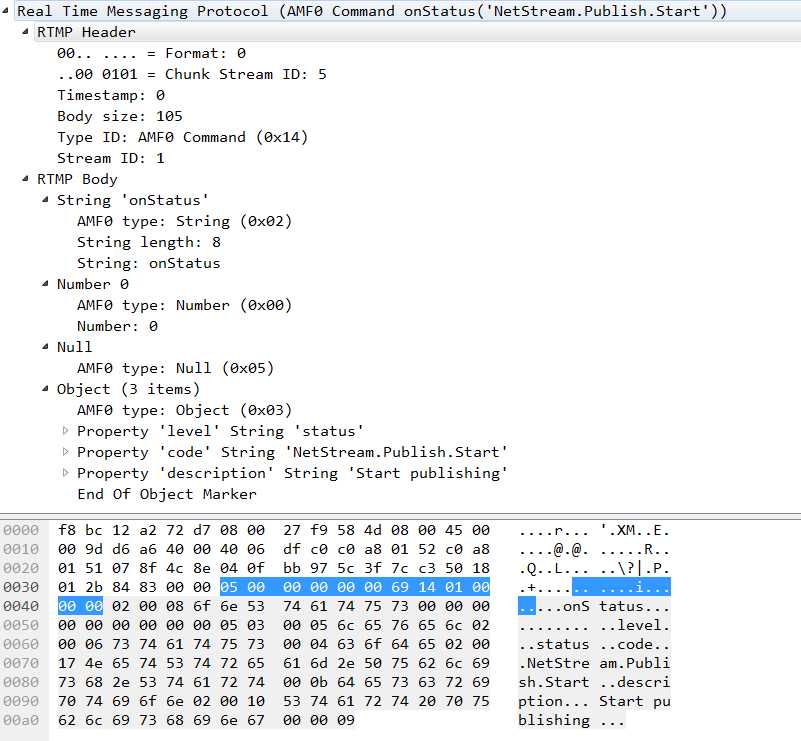
之後又回到 epoll_wait 處,等待監聽的事件觸發。接下來的分析先看 nginx 的一段列印:
ngx_process_cycle.c:ngx_single_process_cycle:307 worker cycle
ngx_epoll_module.c:ngx_epoll_process_events:798 epoll timer: 59761
ngx_epoll_module.c:ngx_epoll_process_events:860 epoll: fd:9 ev:0004 d:088F6950
ngx_event_timer.h:ngx_event_del_timer:36 event timer del: 9: 958705070
ngx_send.c:ngx_unix_send:37 send: fd:9 1537 of 1537
ngx_epoll_module.c:ngx_epoll_del_event:686 epoll del event: fd:9 op:3 ev:00002001
ngx_rtmp_handshake.c:ngx_rtmp_handshake_send:544 handshake: stage 7
ngx_recv.c:ngx_unix_recv:58 recv: eof:0, avail:0
ngx_event_timer.h:ngx_event_add_timer:82 event timer add: 9: 60000:958705071
ngx_epoll_module.c:ngx_epoll_process_events:860 epoll: fd:5 ev:0001 d:088F67E8
ngx_event_accept.c:ngx_event_accept:58 accept on 0.0.0.0:1935, ready: 0
ngx_alloc.c:ngx_memalign:66 posix_memalign: 08930870:4096 @16
ngx_event_accept.c:ngx_event_accept:293 *3 accept: 192.168.1.82:39334 fd:10
ngx_rtmp_init.c:ngx_rtmp_init_connection:124 *3 client connected ‘192.168.1.82‘
ngx_rtmp_handler.c:ngx_rtmp_set_chunk_size:823 setting chunk_size=128
ngx_alloc.c:ngx_memalign:66 posix_memalign: 089318A0:4096 @16
ngx_rtmp_limit_module.c:ngx_rtmp_limit_connect:87 rtmp limit: connect
ngx_rtmp_handshake.c:ngx_rtmp_handshake:589 handshake: start server handshake
ngx_rtmp_handshake.c:ngx_rtmp_alloc_handshake_buffer:208 handshake: allocating buffer
ngx_recv.c:ngx_unix_recv:58 recv: eof:0, avail:0
ngx_event_timer.h:ngx_event_add_timer:82 event timer add: 10: 60000:958705071
ngx_epoll_module.c:ngx_epoll_add_event:625 epoll add event: fd:10 op:1 ev:80002001
ngx_event.c:ngx_process_events_and_timers:247 timer delta: 1
ngx_process_cycle.c:ngx_single_process_cycle:307 worker cycle
ngx_epoll_module.c:ngx_epoll_process_events:798 epoll timer: 59760
ngx_epoll_module.c:ngx_epoll_process_events:860 epoll: fd:10 ev:0001 d:088F69C8
ngx_event_timer.h:ngx_event_del_timer:36 event timer del: 10: 958705071
ngx_recv.c:ngx_unix_recv:58 recv: eof:0, avail:1
ngx_recv.c:ngx_unix_recv:72 recv: fd:10 1537 of 1537
ngx_epoll_module.c:ngx_epoll_del_event:686 epoll del event: fd:10 op:2 ev:00000000
ngx_rtmp_handshake.c:ngx_rtmp_handshake_recv:429 handshake: stage 2
ngx_rtmp_handshake.c:ngx_rtmp_handshake_parse_challenge:303 handshake: peer version=14.13.0.12 epoch=958645070
ngx_rtmp_handshake.c:ngx_rtmp_handshake_parse_challenge:320 handshake: digest found at pos=638
ngx_send.c:ngx_unix_send:37 send: fd:10 1537 of 1537
ngx_rtmp_handshake.c:ngx_rtmp_handshake_send:544 handshake: stage 3
ngx_send.c:ngx_unix_send:37 send: fd:10 1536 of 1536
ngx_rtmp_handshake.c:ngx_rtmp_handshake_send:544 handshake: stage 4
ngx_recv.c:ngx_unix_recv:58 recv: eof:0, avail:1
ngx_recv.c:ngx_unix_recv:72 recv: fd:10 -1 of 1536
ngx_recv.c:ngx_unix_recv:150 recv() not ready (11: Resource temporarily unavailable)
ngx_event_timer.h:ngx_event_add_timer:82 event timer add: 10: 60000:958705071
ngx_epoll_module.c:ngx_epoll_add_event:625 epoll add event: fd:10 op:1 ev:80002001
ngx_event.c:ngx_process_events_and_timers:247 timer delta: 0
ngx_process_cycle.c:ngx_single_process_cycle:307 worker cycle
ngx_epoll_module.c:ngx_epoll_process_events:798 epoll timer: 59760
ngx_epoll_module.c:ngx_epoll_process_events:860 epoll: fd:9 ev:0001 d:088F6950
ngx_event_timer.h:ngx_event_del_timer:36 event timer del: 9: 958705071
ngx_recv.c:ngx_unix_recv:58 recv: eof:0, avail:1
ngx_recv.c:ngx_unix_recv:72 recv: fd:9 1537 of 1537
ngx_epoll_module.c:ngx_epoll_del_event:686 epoll del event: fd:9 op:2 ev:00000000
ngx_rtmp_handshake.c:ngx_rtmp_handshake_recv:429 handshake: stage 8
ngx_rtmp_handshake.c:ngx_rtmp_handshake_parse_challenge:303 handshake: peer version=13.10.14.13 epoch=958645071
ngx_rtmp_handshake.c:ngx_rtmp_handshake_parse_challenge:320 handshake: digest found at pos=557
ngx_recv.c:ngx_unix_recv:58 recv: eof:0, avail:1
ngx_recv.c:ngx_unix_recv:72 recv: fd:9 1536 of 1536
ngx_rtmp_handshake.c:ngx_rtmp_handshake_recv:429 handshake: stage 9
ngx_send.c:ngx_unix_send:37 send: fd:9 1536 of 1536
ngx_rtmp_handshake.c:ngx_rtmp_handshake_send:544 handshake: stage 10
ngx_rtmp_handshake.c:ngx_rtmp_handshake_done:362 handshake: done
ngx_rtmp_relay_module.c:ngx_rtmp_relay_handshake_done:1319 rtmp relay module: handhshake done首先 fd = 9 為連線上游伺服器(192.168.1.82:1935) 時建立的作為客戶端的 STREAM 型別的 socket 套接字,而 fd = 5 為 nginx
啟動時建立的 STREAM 型別的 socket 監聽套接字。因此,從列印中可以看出,上面的列印是這麼一個流程:
- epoll 監聽的 fd 為 9 的套接字可寫,因此呼叫該套接字上寫事件的回撥函式,從之前的原始碼可知,為
ngx_rtmp_handshake_send 函式,該函式將已經準備好的 C0 和 C1 通過該寫事件對應的 send 函式,即
ngx_unix_send 函式傳送給上游伺服器(192.168.1.82:1935);傳送完後進入 CLIENT_RECV_CHALLENGE(7) 階段,
該階段為等待接收伺服器 S0 和 S1 的階段; - epool 監控到伺服器 fd:5 有資料可讀,且為新連線,因此呼叫 ngx_event_accept 接收該客戶端(192.168.1.82:39334)的
連線,接受連線後伺服器使用 fd:10 與客戶端進行互動,接著伺服器開始進入 handshake 階段; - 下面就開始了伺服器 (192.168.1.82:1935, fd = 10) 和 客戶端(192.168.1.82:39334, fd = 9) 的 hanshake 過程,就不再詳
述,和之前分析的 hanshake 一樣。
客戶端傳送 C2 後,會進入 NGX_RTMP_HANDSHAKE_CLIENT_DONE(10) 階段,接著會呼叫該函式 ngx_rtmp_handshake_done:
static void
ngx_rtmp_handshake_done(ngx_rtmp_session_t *s)
{
ngx_rtmp_free_handshake_buffers(s);
ngx_log_debug0(NGX_LOG_DEBUG_RTMP, s->connection->log, 0,
"handshake: done");
if (ngx_rtmp_fire_event(s, NGX_RTMP_HANDSHAKE_DONE,
NULL, NULL) != NGX_OK)
{
ngx_rtmp_finalize_session(s);
return;
}
ngx_rtmp_cycle(s);
}該函式接著會呼叫到 ngx_rtmp_relay_handshake_done 函式:
static ngx_int_t
ngx_rtmp_relay_handshake_done(ngx_rtmp_session_t *s, ngx_rtmp_header_t *h,
ngx_chain_t *in)
{
ngx_log_debug0(NGX_LOG_DEBUG_RTMP, s->connection->log, 0, "rtmp relay module: handhshake done");
ngx_rtmp_relay_ctx_t *ctx;
ctx = ngx_rtmp_get_module_ctx(s, ngx_rtmp_relay_module);
if (ctx == NULL || !s->relay) {
ngx_log_debug0(NGX_LOG_DEBUG_RTMP, s->connection->log, 0, "rtmp relay module: return");
return NGX_OK;
}
/* 主要是向伺服器傳送 connect 連線命令 */
return ngx_rtmp_relay_send_connect(s);
}2.7 客戶端(fd = 9)傳送:connect
客戶端(192.168.1.82:39334, fd = 9) hanshake 成功後會向伺服器傳送 connec 連線命令。
2.7.1 ngx_rtmp_relay_send_connect
static ngx_int_t
ngx_rtmp_relay_send_connect(ngx_rtmp_session_t *s)
{
ngx_log_debug0(NGX_LOG_DEBUG_RTMP, s->connection->log, 0, "rtmp relay module: send connect");
static double trans = NGX_RTMP_RELAY_CONNECT_TRANS;
static double acodecs = 3575;
static double vcodecs = 252;
static ngx_rtmp_amf_elt_t out_cmd[] = {
{ NGX_RTMP_AMF_STRING,
ngx_string("app"),
NULL, 0 }, /* <-- fill */
{ NGX_RTMP_AMF_STRING,
ngx_string("tcUrl"),
NULL, 0 }, /* <-- fill */
{ NGX_RTMP_AMF_STRING,
ngx_string("pageUrl"),
NULL, 0 }, /* <-- fill */
{ NGX_RTMP_AMF_STRING,
ngx_string("swfUrl"),
NULL, 0 }, /* <-- fill */
{ NGX_RTMP_AMF_STRING,
ngx_string("flashVer"),
NULL, 0 }, /* <-- fill */
{ NGX_RTMP_AMF_NUMBER,
ngx_string("audioCodecs"),
&acodecs, 0 },
{ NGX_RTMP_AMF_NUMBER,
ngx_string("videoCodecs"),
&vcodecs, 0 }
};
static ngx_rtmp_amf_elt_t out_elts[] = {
{ NGX_RTMP_AMF_STRING,
ngx_null_string,
"connect", 0 },
{ NGX_RTMP_AMF_NUMBER,
ngx_null_string,
&trans, 0 },
{ NGX_RTMP_AMF_OBJECT,
ngx_null_string,
out_cmd, sizeof(out_cmd) }
};
ngx_rtmp_core_app_conf_t *cacf;
ngx_rtmp_core_srv_conf_t *cscf;
ngx_rtmp_relay_ctx_t *ctx;
ngx_rtmp_header_t h;
size_t len, url_len;
u_char *p, *url_end;
cacf = ngx_rtmp_get_module_app_conf(s, ngx_rtmp_core_module);
cscf = ngx_rtmp_get_module_srv_conf(s, ngx_rtmp_core_module);
ctx = ngx_rtmp_get_module_ctx(s, ngx_rtmp_relay_module);
if (cacf == NULL || ctx == NULL) {
return NGX_ERROR;
}
/* app */
if (ctx->app.len) {
out_cmd[0].data = ctx->app.data;
out_cmd[0].len = ctx->app.len;
} else {
out_cmd[0].data = cacf->name.data;
out_cmd[0].len = cacf->name.len;
}
/* tcUrl */
if (ctx->tc_url.len) {
out_cmd[1].data = ctx->tc_url.data;
out_cmd[1].len = ctx->tc_url.len;
} else {
len = sizeof("rtmp://") - 1 + ctx->url.len +
sizeof("/") - 1 + ctx->app.len;
p = ngx_palloc(s->connection->pool, len);
if (p == NULL) {
return NGX_ERROR;
}
out_cmd[1].data = p;
p = ngx_cpymem(p, "rtmp://", sizeof("rtmp://") - 1);
url_len = ctx->url.len;
url_end = ngx_strlchr(ctx->url.data, ctx->url.data + ctx->url.len, ‘/‘);
if (url_end) {
url_len = (size_t) (url_end - ctx->url.data);
}
p = ngx_cpymem(p, ctx->url.data, url_len);
*p++ = ‘/‘;
p = ngx_cpymem(p, ctx->app.data, ctx->app.len);
out_cmd[1].len = p - (u_char *)out_cmd[1].data;
}
/* pageUrl */
out_cmd[2].data = ctx->page_url.data;
out_cmd[2].len = ctx->page_url.len;
/* swfUrl */
out_cmd[3].data = ctx->swf_url.data;
out_cmd[3].len = ctx->swf_url.len;
/* flashVer */
if (ctx->flash_ver.len) {
out_cmd[4].data = ctx->flash_ver.data;
out_cmd[4].len = ctx->flash_ver.len;
} else {
out_cmd[4].data = NGX_RTMP_RELAY_FLASHVER;
out_cmd[4].len = sizeof(NGX_RTMP_RELAY_FLASHVER) - 1;
}
ngx_memzero(&h, sizeof(h));
h.csid = NGX_RTMP_RELAY_CSID_AMF_INI;
h.type = NGX_RTMP_MSG_AMF_CMD;
return ngx_rtmp_send_chunk_size(s, cscf->chunk_size) != NGX_OK
|| ngx_rtmp_send_ack_size(s, cscf->ack_window) != NGX_OK
|| ngx_rtmp_send_amf(s, &h, out_elts,
sizeof(out_elts) / sizeof(out_elts[0])) != NGX_OK
? NGX_ERROR
: NGX_OK;
}傳送完這幾個 RTMP 包,後,又回到 epoll_wait 中進行監聽。
下面的分析區分一個伺服器,兩個客戶端:
- 伺服器:192.168.1.82:1935
- 客戶端:obs 推流
- 客戶端:192.168.1.82:xxxx
2.8 伺服器 接收 客戶端 obs: amf_meta(18)
此時,監聽到 obs 客戶端傳送的型別為 amf_meta(18) 的 rtmp 訊息。
receive: @setDataFrame(meta_data 18) 圖(13)
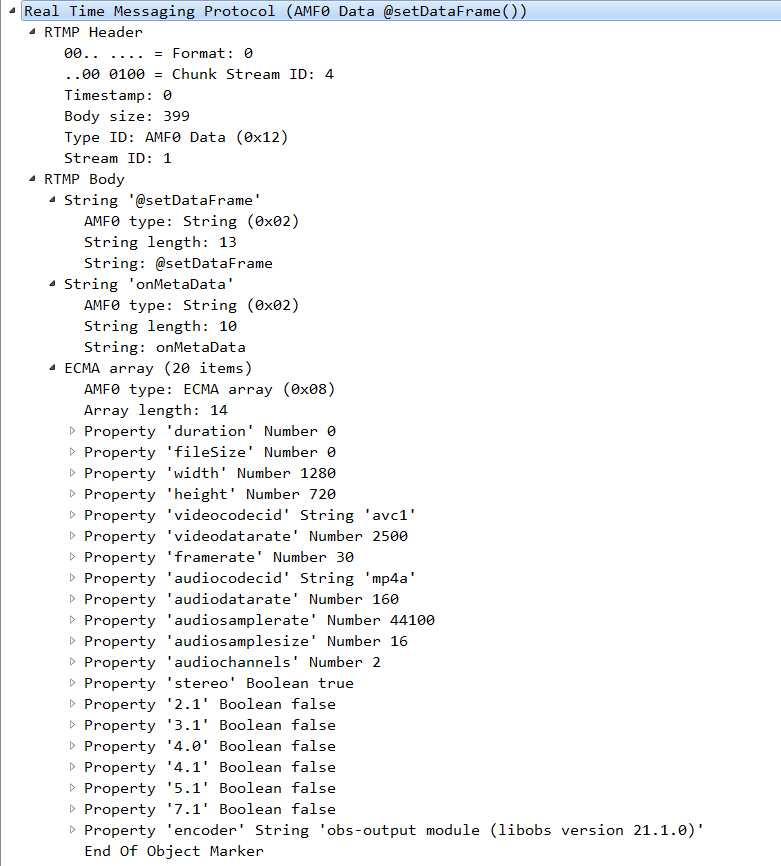
對於 "@setDataFrame",僅有 ngx_rtmp_codec_module 模組對其設定了會調函式,為 ngx_rtmp_codec_meta_data 函式:
2.8.1 ngx_rtmp_codec_meta_data
static ngx_int_t
ngx_rtmp_codec_meta_data(ngx_rtmp_session_t *s, ngx_rtmp_header_t *h,
ngx_chain_t *in)
{
ngx_rtmp_codec_app_conf_t *cacf;
ngx_rtmp_codec_ctx_t *ctx;
ngx_uint_t skip;
static struct {
double width;
double height;
double duration;
double frame_rate;
double video_data_rate;
double video_codec_id_n;
u_char video_codec_id_s[32];
double audio_data_rate;
double audio_codec_id_n;
u_char audio_codec_id_s[32];
u_char profile[32];
u_char level[32];
} v;
static ngx_rtmp_amf_elt_t in_video_codec_id[] = {
{ NGX_RTMP_AMF_NUMBER,
ngx_null_string,
&v.video_codec_id_n, 0 },
{ NGX_RTMP_AMF_STRING,
ngx_null_string,
&v.video_codec_id_s, sizeof(v.video_codec_id_s) },
};
static ngx_rtmp_amf_elt_t in_audio_codec_id[] = {
{ NGX_RTMP_AMF_NUMBER,
ngx_null_string,
&v.audio_codec_id_n, 0 },
{ NGX_RTMP_AMF_STRING,
ngx_null_string,
&v.audio_codec_id_s, sizeof(v.audio_codec_id_s) },
};
static ngx_rtmp_amf_elt_t in_inf[] = {
{ NGX_RTMP_AMF_NUMBER,
ngx_string("width"),
&v.width, 0 },
{ NGX_RTMP_AMF_NUMBER,
ngx_string("height"),
&v.height, 0 },
{ NGX_RTMP_AMF_NUMBER,
ngx_string("duration"),
&v.duration, 0 },
{ NGX_RTMP_AMF_NUMBER,
ngx_string("framerate"),
&v.frame_rate, 0 },
{ NGX_RTMP_AMF_NUMBER,
ngx_string("fps"),
&v.frame_rate, 0 },
{ NGX_RTMP_AMF_NUMBER,
ngx_string("videodatarate"),
&v.video_data_rate, 0 },
{ NGX_RTMP_AMF_VARIANT,
ngx_string("videocodecid"),
in_video_codec_id, sizeof(in_video_codec_id) },
{ NGX_RTMP_AMF_NUMBER,
ngx_string("audiodatarate"),
&v.audio_data_rate, 0 },
{ NGX_RTMP_AMF_VARIANT,
ngx_string("audiocodecid"),
in_audio_codec_id, sizeof(in_audio_codec_id) },
{ NGX_RTMP_AMF_STRING,
ngx_string("profile"),
&v.profile, sizeof(v.profile) },
{ NGX_RTMP_AMF_STRING,
ngx_string("level"),
&v.level, sizeof(v.level) },
};
static ngx_rtmp_amf_elt_t in_elts[] = {
{ NGX_RTMP_AMF_STRING,
ngx_null_string,
NULL, 0 },
{ NGX_RTMP_AMF_OBJECT,
ngx_null_string,
in_inf, sizeof(in_inf) },
};
cacf = ngx_rtmp_get_module_app_conf(s, ngx_rtmp_codec_module);
ctx = ngx_rtmp_get_module_ctx(s, ngx_rtmp_codec_module);
if (ctx == NULL) {
ctx = ngx_pcalloc(s->connection->pool, sizeof(ngx_rtmp_codec_ctx_t));
ngx_rtmp_set_ctx(s, ctx, ngx_rtmp_codec_module);
}
ngx_memzero(&v, sizeof(v));
/* use -1 as a sign of unchanged data;
* 0 is a valid value for uncompressed audio */
v.audio_codec_id_n = -1;
/* FFmpeg sends a string in front of actal metadata; ignore it */
skip = !(in->buf->last > in->buf->pos
&& *in->buf->pos == NGX_RTMP_AMF_STRING);
if (ngx_rtmp_receive_amf(s, in, in_elts + skip,
sizeof(in_elts) / sizeof(in_elts[0]) - skip))
{
ngx_log_error(NGX_LOG_ERR, s->connection->log, 0,
"codec: error parsing data frame");
return NGX_OK;
}
ctx->width = (ngx_uint_t) v.width;
ctx->height = (ngx_uint_t) v.height;
ctx->duration = (ngx_uint_t) v.duration;
ctx->frame_rate = (ngx_uint_t) v.frame_rate;
ctx->video_data_rate = (ngx_uint_t) v.video_data_rate;
ctx->video_codec_id = (ngx_uint_t) v.video_codec_id_n;
ctx->audio_data_rate = (ngx_uint_t) v.audio_data_rate;
ctx->audio_codec_id = (v.audio_codec_id_n == -1
? 0 : v.audio_codec_id_n == 0
? NGX_RTMP_AUDIO_UNCOMPRESSED : (ngx_uint_t) v.audio_codec_id_n);
ngx_memcpy(ctx->profile, v.profile, sizeof(v.profile));
ngx_memcpy(ctx->level, v.level, sizeof(v.level));
ngx_log_debug8(NGX_LOG_DEBUG_RTMP, s->connection->log, 0,
"codec: data frame: "
